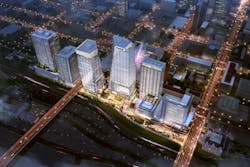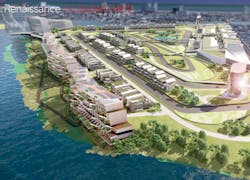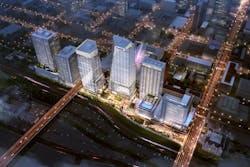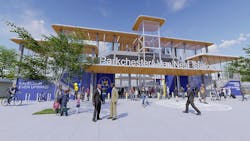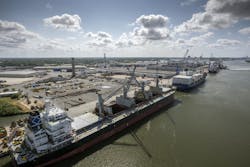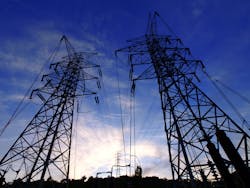While 2023 may turn out to be a slower year for the construction market, there’s still plenty of action with some types of projects in certain fast-growing local markets. Some of this construction activity will be fueled by federal economic stimulus like the Creating Helpful Incentives to Produce Semiconductors (CHIPS) Act to incentivize onshoring of semiconductor manufacturing and the IRA legislation that provides financial incentives/tax breaks for a broad swath of construction activity, including (but not limited to) the revitalization of the United States electrical grid, mass transit, ports, electric vehicle charging stations, and renewables.
Considering the fact that electrical construction accounts for no less than 10% of a typical construction project, when a billion-dollar trophy job breaks ground, it can provide engineering firms doing the design, electrical contractors working on the job, and distributors, reps, and manufacturers providing supply and support services with a nice chunk of change.
Following are 10 billion-dollar projects that highlight the construction niches we believe may offer the most promise in 2023.
SEMICONDUCTOR PLANTS
Skywater-Purdue University Private/Public Partnership, West Lafayette, Ind.
While there’s been all sorts of plans announced for multi-billion-dollar semiconductor plants, the public-private partnership engineered by Skywater Technology, the state of Indiana, and Purdue University to jointly develop a $1.8-billion semiconductor factory in Purdue’s Discovery Park District is unique. One of the big draws to building a new chip factory adjacent the Purdue campus was the pipeline of engineering talent in the university’s technical programs.
Announced in July 2022, the project will be funded in part by CHIPS for America Act financial incentives. “Federal investment will enable SkyWater to more quickly expand our efforts to address the need for strategic reshoring of semiconductor manufacturing,” said Thomas Sonderman, SkyWater president and CEO, in a recent press release. “Through our alliance with the Indiana Economic Development Corporation and Purdue Research Foundation, we have a unique opportunity to increase domestic production, shore up our supply chains, and lay the groundwork for manufacturing technologies that will support growing demand for microelectronics.”
OFFSHORE WIND
South Fork Wind & South Wind Offshore Wind Farms (off the coast of Long Island, N.Y.)
The first of several wind farms that will be built off the New York coast has started construction. The South Fork Wind project being built by Orsted and Eversource will have 12 Siemens-Gamesa 11MW turbines that will generate approximately 130MW of power — enough to power more than 70,000 homes. It’s expected to begin producing power for Long Island by the end of 2023.
In addition to construction jobs for the offshore wind farm, New York state is building a new operations and maintenance hub in Port Jefferson, N.Y., which will create up to 100 new and permanent full-time jobs, and the $10-million National Workforce Training Center on Long Island. This facility will offer training programs that will create job opportunities in offshore wind industry. A larger wind offshore wind farm, Sunrise Wind, will generate 924MW and have the potential capacity to power nearly 600,000 homes. It’s expected to begin power production in 2025.
Offshore wind farms like South Fork Wind and Sunrise Wind offer the electrical industry a variety of new revenue opportunities. Wire and cable manufacturers compete for contracts to supply the massive undersea cables, and the onshore substations and staging areas at ports will offer the electrical construction industry some solid bidding opportunities in the years to come.
MICROGRIDS
Renaissance at Bader Field, Atlantic City, N.J.
Microgrids may evolve into a major new decentralized power source — and a new market opportunity for electrical contractors, distributors, reps, manufacturers, design firms, and other electrical professionals.
A microgrid produces local power outside of the conventional electrical grid from solar panels, wind turbines, natural-gas powered turbines, and other power sources. Microgrids often mix and match these power sources to provide power for municipalities and cities, schools or college campuses, military bases, airports, and off-the-grid applications. They can provide primary power or emergency/backup power and are often connected to the grid to provide excess power to a local utility.
The proposed Renaissance at Bader Field development on brownfield site at a former airport in Atlantic City, N.J., is a $2.7-billion project powered in part by a microgrid that would include LEED-certified luxury and affordable multi-family housing, offices, stores, and a 2.44-mile Formula One racetrack and hotel. Deem Enterprises (the developer) and ProtoGen (the contractor) say the microgrid would be powered by natural gas turbines but would eventually be transitioned to clean hydrogen. Solar panels on the roofs of the buildings in the development would provide additional power.
Ken Wright, co-founder and president of ProtoGen, said in a presentation on microgrid opportunities at the 2021 NECA conference that two of the biggest challenges currently restricting the growth of microgrids are a regulatory thicket at the local level that often sparks debates about how to bring the power generated by microgrids to end-users and the perception by some utilities that microgrids installed by commercial customers or third-party power providers are a threat to their primary role of being a provider of electrical power.
HOMEBUILDING IN FAST-GROWING METROS
Teravalis Mega-Development, Phoenix
Sure, residential development has hit the skids in many local metropolitan areas. Over the past few years, however, homebuilders in Phoenix have pulled building permits at rates that would amaze folks in most other markets. In 2022, builders pulled 25,831 single-family permits through November — a number that only the Houston and Dallas metros topped. Since 2019, U.S. Bureau of Census data shows that Phoenix builders pulled more than 91,000 building permits.
The truly massive Teravalis development that broke ground near the western edge of Phoenix’s Valley of the Sun will make those numbers look like chump change. Over the next few years, the developer intends to build 100,000 homes on 37,000 acres, as well as 55 million square feet of commercial space.
“Since 2015, Arizona has welcomed over 584,000 new residents, and we don’t expect that momentum to stop anytime soon,” said Arizona Gov. Doug Ducey in a press release. “This increases the demand for housing opportunities, and Howard Hughes is providing quality housing options for current and future Arizonans.”
URBAN MIXED-USE PROJECTS
Nashville Yards, Nashville, Tenn.
Although the nonresidential construction segment as a whole may be down in 2023, we still see plenty of activity in downtown revitalization projects. One of the larger urban mixed-use projects now underway is the $1-billion, 18-acre Nashville Yards being developed by Anschutz Entertainment Group (AEG) and Southwest Value Partners. This mixed-used entertainment district will be anchored by a 4,000-capacity, state-of-the-art country music venue; an upscale eight-screen cinema; more than 1,000 hotel rooms, restaurants, and stores; 275,000 square feet of Class A office space; and three residential towers.
Other cities with mixed-use projects underway or planned (and valued at $1 billion or more in total construction value) include Google’s plans for the $19-billion Downtown West development in San Jose, Calif.; the $3.5-billion Seaport San Diego project proposal; the $2-billion GreenCity in Richmond, Va.; and Washington, D.C.’s $2-billion Poplar Place waterfront redevelopment. While all of these projects will have a big impact on their cities, none is quite as large as the $25-billion, multi-year Hudson Yards development in the Big Apple nearing completion.
MASS TRANSIT
New York’s Metro-North Penn Station Access Project, Bronx, N.Y.
Light-rail, and passenger service expansion projects typically require millions of dollars in medium- and high-voltage electrical equipment and draw other businesses to new or renovated stations. The $3.2-billion expansion of New York’s subway service in Bronx, N.Y., which broke ground recently, is the Metropolitan Transit Authority’s (MTA) largest expansion since 1983 and will add four new stations to an area of the city that historically had poor direct access to Manhattan’ Penn Station and the rest of the city’s subway system as well as Amtrak.
The new stations, which will be in Hunts Point, Parkchester/Van Nest, Morris Park, and Co-Op City, are expected to drastically reduce commute times for hundreds of thousands of residents who live near these subway stations.
AIRPORTS
JFK Terminal One, New York
While airport renovation projects have been quite common in recent years, the $9.5-billion price tag for JFK International Airport’s new Terminal One caught our eye. The project, which broke ground in September, is part of a $18-billion revitalization of JFK that included several other completed terminal renovations.
Airport construction in the New York metropolitan area has been going gangbusters in recent years. The work at JFK follows the $8-billion renovation of nearby LaGuardia Airport as well as Newark’s $3-billion Terminal A project, which was completed in late 2022.
According to a press release from the State of New York, when complete, the new JFK terminal will be the largest at JFK Airport and require 6,000 construction workers on-site (and an estimated 780 electrical contractor employees). The release also indicated JFK’s New Terminal One will have 23 gates and cover 2.4 million square feet. It’s massive — as a point of comparison, it will be nearly the same size as the new LaGuardia Airport’s two new terminals combined. Construction of the new terminal will take place in phases. The first phase is expected to open in 2026, and all three phases are anticipated to finish up in 2030.
PORT INVESTMENT
Port of Savannah, Savannah, Ga.
There’s a surprising amount of electrical construction work at ports, including not only lighting, wire, and cable for warehouses and docks, but also plenty of control equipment and cabling for the cranes that handle the shipping containers. This construction segment got a ton of financial stimulus from the federal government’s Infrastructure Investment and Jobs Act, which allocated $17 billion in funding for port and waterway renovation.
One of the larger port projects now underway is the Georgia Ports Authority Board’s renovations of the Port of Savannah’s Ocean Terminal and docks to better accommodate its expanding container operation. According to a press release, construction has started on 360,000 square feet of dockside warehousing that will serve auto processing, three additional buildings, 85 acres of auto storage space, and new cranes.
ELECTRIC VEHICLE BATTERY PLANTS
Envision AESC Factory to Build EV Batteries for BMW, Florence, S.C.
Over the past two years, EV battery manufacturers have announced plans for tens of billions in combined investment for EV battery factories in the United States. The December 2022 announcement that Envision AESC would invest $810 million in a new EV factory in South Carolina to supply BMW with EV batteries was the latest news about a trend that’s juicing up industrial construction nationwide. A press release from South Carolina’s Office of the Governor said the new factory would create 1,170 new jobs.
BMW is also investing in its United States EV operations in a big way, recently announcing it will spend $1 billion to add EV manufacturing capacity to its Spartanburg, S.C.-based plant and will invest $700 million in Woodruff, S.C. to build a 1-million-square-foot high-voltage battery assembly facility in nearby Woodruff, S.C. By 2030, the company says it will build at least six fully electric models in the United States.
ELECTRIC GRID EXPANSION & REVITALIZATION
610-Mile Power Pathway Project, Eastern Colorado
Quanta Services, the Houston-based electrical contractor with a specialty in electric transmission and utility-scale renewable projects, recently won a big bid in Colorado that will help the state get more electrical power from new solar and wind farms. According to a Quanta press release, Xcel Energy selected the company as the prime contractor for the massive Power Pathway project, which will include the construction of approximately 610 miles of 345kV transmission infrastructure, primarily in eastern Colorado.
The project includes the installation of four new substations and the expansion of four existing substations. It’s designed to increase the reliability of Colorado’s power grid and enable future renewable energy development in the state, including approximately 5,500MW of new wind, solar, and other resources Xcel Energy plans to add through 2030.
According to the press release, certain segments of the project are expected to be completed in 2025 with others in 2026 and 2027. Preconstruction activities have already begun, and construction on the first segment is scheduled to begin in mid-2023.
About the Author
Jim Lucy
Editor-in-Chief, Electrical Wholesaling & Electrical Marketing
Over the past 40-plus years, hundreds of Jim’s articles have been published in Electrical Wholesaling, Electrical Marketing newsletter and Electrical Construction & Maintenance magazine on topics such as electric vehicles, solar and wind development, energy-efficient lighting and local market economics. In addition to his published work, Jim regularly gives presentations on these topics to C-suite executives, industry groups and investment analysts.
He launched a new subscription-based data product for Electrical Marketing that offers electrical sales potential estimates and related market data for more than 300 metropolitan areas. In 1999, he published his first book, “The Electrical Marketer’s Survival Guide” for electrical industry executives looking for an overview of key market trends.
While managing Electrical Wholesaling’s editorial operations, Jim and the publication’s staff won several Jesse H. Neal awards for editorial excellence, the highest honor in the business press, and numerous national and regional awards from the American Society of Business Press Editors. He has a master’s degree in communications and a bachelor’s degree in journalism from Glassboro State College, Glassboro, N.J. (now Rowan University) and studied electrical design at New York University and graphic design at the School for Visual Arts.
